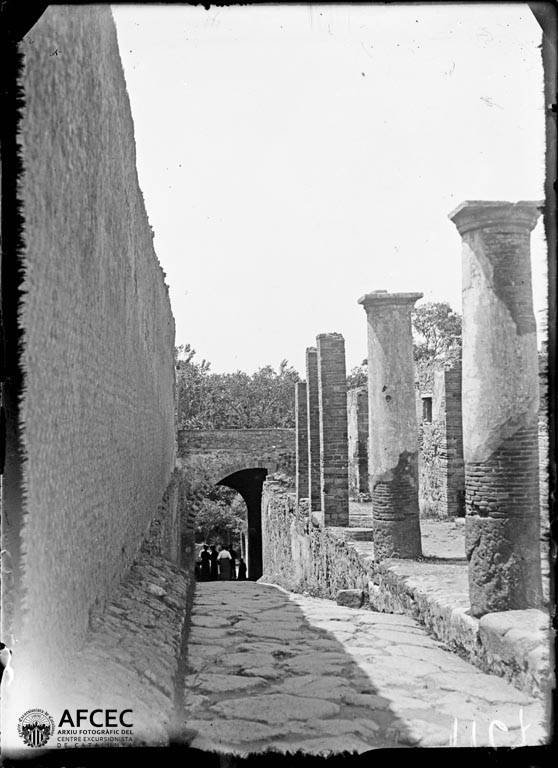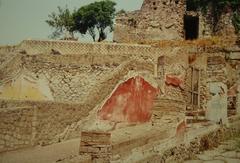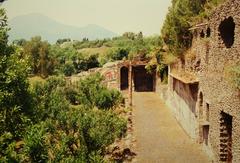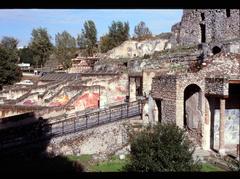
Porta Marina Pompeii: Visiting Hours, Tickets, and Historical Sites Guide
Date: 14/06/2025
Introduction to Porta Marina Pompeii
Porta Marina, known as the “Marine Gate,” stands as one of the most iconic and well-preserved entrances to the ancient city of Pompeii, Italy. This gateway, oriented toward the ancient coastline and harbor, was instrumental in connecting Pompeii to the Bay of Naples, serving as a hub for trade, defense, and urban activity in the Roman era. With its distinctive dual-arched design—one for carts and animals, the other for pedestrians—Porta Marina exemplifies the sophistication of Roman urban planning and architecture. Its location near major landmarks such as the Forum, Temple of Venus, and Villa of the Mysteries underscores its central role in Pompeii’s daily life.
Discovered and excavated in the mid-19th century, Porta Marina is now the main entrance to the Pompeii Archaeological Park and is equipped with modern visitor amenities, including ticket offices, guided tour services, and accessibility features. This guide offers a comprehensive overview of Porta Marina’s historical significance, architectural highlights, visiting hours, ticket information, accessibility, and tips for making the most of your visit. For the latest details, consult official resources such as the Pompeii Archaeological Park website, as well as trusted travel guides (Nomad Epicureans, Italy Things To Do).
Contents
- Historical Background and Significance
- Architectural Features
- Excavation and Preservation
- Visiting Hours and Ticketing
- Accessibility and Visitor Amenities
- Navigating from Porta Marina
- Crowd Management and Best Times to Visit
- Guided Tours and Self-Guided Options
- Practical Tips for Visitors
- Dining and Refreshments
- Nearby Attractions
- FAQ
- Conclusion
- Sources
Historical Background and Significance
Porta Marina, or the Marine Gate, was one of the main access points to ancient Pompeii, positioned to face the sea and facilitate both trade and defense (pompeiiinpictures.com). The gate’s name reflects its orientation toward the harbor, which was crucial for commerce and communication with the wider Roman world (Nomad Epicureans). Archaeological evidence reveals that the gate was integrated into the city’s fortifications, evolving from the Samnite through the Roman periods, and served as a focal point for merchants, travelers, and dignitaries arriving from the Mediterranean.
Architectural Features
The dual-arched structure is a hallmark of Roman engineering, with a larger arch (about 3.5 meters wide) for carts and a smaller one (about 1.5 meters) for pedestrians (pompeiiinpictures.com). Built from local volcanic stone and tuff, and later reinforced with brick and concrete, Porta Marina also features niches (one of which once housed a statue of Minerva), remnants of painted plaster, and traces of the city’s defensive walls. Above the arches, you can still see fragments of battlements and towers that once provided security for the city (Van der Graaff, 2018).
Excavation and Preservation
Porta Marina was systematically excavated in the mid-19th century under Giuseppe Fiorelli. The discovery of Minerva statue fragments and inscriptions attesting to imperial restorations highlighted the gate’s importance. Despite suffering damage during World War II, restoration efforts have stabilized and preserved Porta Marina, making it a prominent symbol of Pompeii (pompeiiinpictures.com).
Visiting Hours and Ticketing
Hours
- April–October: 9:00 am – 7:00 pm (last entry 5:30 pm)
- November–March: 9:00 am – 5:00 pm (last entry 3:30 pm)
- Closed: January 1, May 1, December 25
Always check the official site for up-to-date opening hours.
Ticketing
- Standard adult ticket: €22.00
- Reduced (EU citizens 18–25): €2.00
- Free: Under 18 and on the first Sunday of each month (limited availability)
- Combined tickets: Available for suburban villas and additional sites
Note: Since November 2023, a daily cap of 20,000 visitors and nominative (name-specific) ticketing is in place. Bring photo ID matching your ticket (pompeiisites.org).
Where to Buy:
- Online at the official website (recommended)
- On-site at the Porta Marina ticket office (expect queues, especially in the morning)
Accessibility and Visitor Amenities
Porta Marina is the best-equipped entrance for all visitors:
- Wheelchair accessible: Ramps, barrier-free paths, and free wheelchair rental. The “Pompeii for All” route is designed for accessibility (thepompeii.com).
- Ticket offices and information desk: Staff available for assistance and maps.
- Restrooms: Clean and accessible near the entrance.
- Luggage storage: Available at the nearby train station (atickettotakeoff.com).
- Shops and cafés: Bookstore, souvenir shops, and refreshment stands at the entrance and inside the park.
- First aid and security: On-site presence for emergencies.
Navigating from Porta Marina
From Porta Marina, visitors have direct access to:
- The Forum: Pompeii’s civic and religious heart
- Basilica, Temples of Apollo and Jupiter
- Stabian Baths, Macellum, House of the Faun, House of the Vettii
- Via dell’Abbondanza: Main street lined with shops and houses
Main routes are paved and relatively even, but some secondary streets are uneven; the accessible route is recommended for those with mobility challenges.
Crowd Management and Best Times to Visit
Porta Marina is the busiest entrance, especially from 9:00–11:00 am and on weekends. To avoid long waits:
- Arrive early (before 9:00 am) or later in the afternoon
- Visit on weekdays
- Book skip-the-line or online tickets in advance
Alternative entrances (Piazza Anfiteatro and Piazza Esedra) are quieter but less convenient for train travelers (thepompeii.com).
Guided Tours and Self-Guided Options
- Guided tours: Highly recommended for first-time visitors. Expert guides provide context and ensure efficient navigation. Tours can be booked in advance and often include skip-the-line access (atickettotakeoff.com).
- Self-guided: Download a map/app or rent an audio guide at the entrance. Focus on key highlights to avoid fatigue.
Practical Tips for Visitors
- Footwear: Wear comfortable shoes for extensive walking on uneven surfaces.
- Water and snacks: Limited options inside; bring a refillable water bottle.
- Sun and rain protection: Bring a hat, sunscreen, sunglasses, and rain gear as needed.
- ID: Required for nominative tickets and reduced/free entry.
- Luggage: Large bags may need to be checked.
- Site regulations: No smoking except in designated areas. Photography is allowed for personal use, but drones and tripods require permission.
Dining and Refreshments
- On site: Autogrill Pompeii (inside the park) and Bar Sgambati (near the train station) serve snacks and drinks (theromanguy.com).
- Nearby: Numerous options in modern Pompeii town.
Nearby Attractions
- Villa of the Mysteries: Renowned for its frescoes, accessible from Porta Marina.
- Antiquarium Pompeii: Museum displaying key artifacts.
- Forum, Temples, and Theaters: Major landmarks within a short walk from the entrance.
Frequently Asked Questions (FAQ)
Q: What are Porta Marina visiting hours?
A: April–October: 9:00 am–7:00 pm (last entry 5:30 pm); November–March: 9:00 am–5:00 pm (last entry 3:30 pm).
Q: How can I buy tickets for Porta Marina?
A: Book online in advance or purchase at the ticket office on-site (expect queues).
Q: Is Porta Marina wheelchair accessible?
A: Yes, it offers the best accessible route and free wheelchair rental.
Q: What is the daily visitor cap?
A: 20,000 admissions per day; tickets are nominative and require matching ID.
Q: Are guided tours available?
A: Yes, bookable in advance or at the entrance, often with skip-the-line access.
Conclusion
Porta Marina is not just the main gateway to Pompeii’s world-renowned archaeological park—it’s a portal into the city’s rich history and vibrant ancient culture. With excellent facilities, strategic location, and proximity to key landmarks, Porta Marina is the top choice for entering Pompeii. Plan ahead by booking tickets online, arriving early, and considering a guided tour for the best experience. For the most current information, consult the official Pompeii Archaeological Park website.
Explore our related articles for in-depth guides to Pompeii’s history, accessibility, and top sites, and download the Audiala app for immersive self-guided tours and updates.


































































